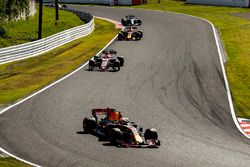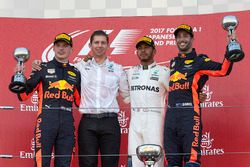Red Bull: 'Magic' engine mode explains Suzuka pace swing
Red Bull thinks that the lack of a 'magic' engine mode for Q3 explained its confusing pace at the Japanese Grand Prix – as it struggled in qualifying before being able to match Mercedes in the race.

Photo by: Glenn Dunbar / Motorsport Images








The Milton Keynes-based team was surprised to be one second off the pace of Mercedes in the fight for grid positions, before Max Verstappen went on to threaten Lewis Hamilton for the race victory.
Red Bull boss Christian Horner thinks that a normal gap in qualifying, thanks to Mercedes' Q3 engine boost, was exacerbated because the Suzuka circuit was more power sensitive this year.
When asked why Red Bull was so much better in the race than in qualifying, Horner said: "I think we run the same modes as we do in qualy. It is a big difference.
"I think this circuit is quite sensitive given that such a large percentage is flat out, even with load-bearing corners.
"So what we seemed to find is, if we pick a corner like 130R, compared to our immediate competitors, even though that corner is flat-out, we never recover on the exit of the corner.
"We drop two tenths in that one corner. It's like Turn 3 in Barcelona, Turn 3 in Russia… those types of corner are particularly painful.
"And with this track now being a bigger percentage full-throttle, particularly towards the end of the first sector, accelerating out of the two Degners, out of the hairpin, around into the last sector… we see it's pretty painful there. We gave away in qualifying the best part of a second.
"Whereas in the race, the chassis has been strong all weekend, we can see from the GPS overlays that the chassis is right there. And obviously they can't run in the high power modes for that duration during the race."
Horner said that the nature of the corners at Suzuka meant that any power deficit was punished more than normal.
"Ultimately it's power, because as soon as you put a little bit of scrub, the engine isn't able to pull through," he said. "It's very sensitive to its acceleration at that point.
"Whereas if you've got the power, you can see that Mercedes and Ferrari are running more downforce than us. They're running a monkey seat, a deeper rear wing, and still their speed is extremely impressive."
Be part of Motorsport community
Join the conversationShare Or Save This Story
Subscribe and access Motorsport.com with your ad-blocker.
From Formula 1 to MotoGP we report straight from the paddock because we love our sport, just like you. In order to keep delivering our expert journalism, our website uses advertising. Still, we want to give you the opportunity to enjoy an ad-free and tracker-free website and to continue using your adblocker.



















Top Comments